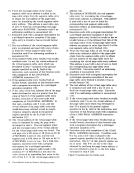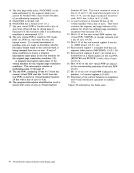9. If the virtual PSW is in EC mode, the following
conditions are verified for byte0 of the virtual PSW and the ope,rand byte that is to replace
it (3):
a. TheDAT mode bit is unchanged.
b.. The PER mask is unchanged.
c. Bits0, 2, 3, and 4 of the new PSW are z.eros. d. Neither the I/O mask (bit 6) nor the
external mask (bit 7) of thePSW is to be
changed from zero to one if a virtual
interruption is pending (that is, if bit0 of
the word containing the virtualPSW address is one l. In the absence of any of these conditions,
execution ends with the invoking of the set
system-mask function of the expanded-virtual
machine assist if that facility is installed. If
that facility is not installed, execution ends with
a program interruption for a privileged
operation exception.
When the virtualPSW is in BC mode,
execution ends if any channel mask,I/O mask,
or external mask is to be changed from zero to
one and a virtual interruption is pending.
Execution ends with a program interruption for
a privileged-operation exception.10. The operand byte fetched is stored with a key
of zero as byte0 of the virtual PSW. Execution of this function ends with completion
of theSET SYSTEM MASK instruction (4).
Figure 15 summarizes the fields used.
Programming Note
The value in bit position 1 of the real control
register0 has no effect on the execution of the
set-system-mask function of the virtual-machine
assist.
FieldControl Address Offset No. of STORE CONTROL The STORE CONTROL instruction is executed for
a virtual machine if the virtual-machine assist is
activated forSystem/370 instructions, unless (1) a
virtual-machine exception is recognized, or (2) the
second operand or some pertinentVM/370 control
field cannot be fetched.
The store-control function of the virtual-machine
assist is performed each time theCPU attempts to
execute aSTORE CONTROL instruction when the
problem-state bit of the realPSW is one.
Execution of this function consists in performing
the following steps:
1. If bits0-3 of control register 6 are not 10XO binary, execution of this function ends, and a
program interruption takes place for a
privileged-operation exception (1.A.1).
2. The word MICCREG, containing the address
of the control blockECBLOK, which in turn
contains the virtual control registers, is fetched
with a key of zero. Execution of this function
ends if an addressing condition is encountered
(1.A.2).
3. If an access condition is encountered in
fetching the second halfword of theSTORE CONTROL instruction, execution of this
function ends, and a program interruption takes
place for the access exception encountered
(1.8).
4. If the second-operand effective address does
not specify a word boundary, execution of this
function ends, and a program interruption takes
place for a privileged-operation exception
(2.A).
5. The virtual control-register values specified by
the R 1 and R 3 fields of the instruction are
fetched from theECBLOK with a key of zero
and stored with thePSW key in ascending
Name Block Type (Hex) Bytes ContentsMICCREG MICBLOK Real 4 4 Address of ECBLOK MICVPSW MICBLOK Real 8 4 Address of VMPSWl EXTCRO ECBLOK Real 0 4 Virtual control
register0 VMPSW VMBLOK Real 0 2 Virtual PSW bits 0-15 Operand 2 -Logical -1 New system mask
1 A virtual interruption is pending if bit0 of MICVPSW is one.
Figure 15. FieldsUsed in SET SYSTEM MASK 20
conditions are verified for byte
it (3):
a. TheDAT mode bit is unchanged.
b.. The PER mask is unchanged.
c. Bits
external mask (bit 7) of the
changed from zero to one if a virtual
interruption is pending (that is, if bit
the word containing the virtual
execution ends with the invoking of the set
system-mask function of the expanded-virtual
machine assist if that facility is installed. If
that facility is not installed, execution ends with
a program interruption for a privileged
operation exception.
When the virtual
execution ends if any channel mask,
or external mask is to be changed from zero to
one and a virtual interruption is pending.
Execution ends with a program interruption for
a privileged-operation exception.
of zero as byte
of the
Figure 15 summarizes the fields used.
Programming Note
The value in bit position 1 of the real control
register
set-system-mask function of the virtual-machine
assist.
Field
a virtual machine if the virtual-machine assist is
activated for
virtual-machine exception is recognized, or (2) the
second operand or some pertinent
field cannot be fetched.
The store-control function of the virtual-machine
assist is performed each time the
execute a
problem-state bit of the real
Execution of this function consists in performing
the following steps:
1. If bits
program interruption takes place for a
privileged-operation exception (1.A.1).
2. The word MICCREG, containing the address
of the control block
contains the virtual control registers, is fetched
with a key of zero. Execution of this function
ends if an addressing condition is encountered
(1.A.2).
3. If an access condition is encountered in
fetching the second halfword of the
function ends, and a program interruption takes
place for the access exception encountered
(1.8).
4. If the second-operand effective address does
not specify a word boundary, execution of this
function ends, and a program interruption takes
place for a privileged-operation exception
(2.A).
5. The virtual control-register values specified by
the R 1 and R 3 fields of the instruction are
fetched from the
and stored with the
Name Block Type (Hex) Bytes Contents
register
1 A virtual interruption is pending if bit
Figure 15. Fields
















































